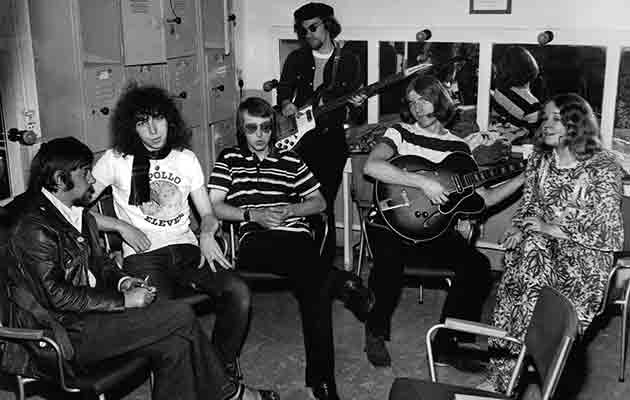The new Fairport, then, consisted of Sandy Denny (vocals), Ashley Hutchings (bass), Richard Thompson (guitar), Simon Nicol (rhythm guitar), and Dave Swarbrick (violin and viola). “Richard was the first electric guitar player I ever worked with,” says Swarbrick. He was already well ensconced in the folk music circuit, having been a member of the Ian Campbell group, and by 1969 had forged a successful duo with guitarist Martin Carthy.
“We were coming from different worlds,” says Richard Thompson, “On “A Sailor’s Life”, you hear us listening to each other and looking for common ground – inventing a middle language as we go. I think it worked because Swarb was ready for something else, and I was ready for something else.”
After a series of auditions, they found their new drummer. Dave Mattacks had worked his way through various underdog rock’n’roll outfits, and had been playing with a professional dance band in Ireland and Scotland for the previous couple of years. From a relatively unglamorous career, Mattacks was about to make history, as the first percussionist to put a rock drumkit behind some of Britain’s oldest songs.
“I didn’t really get it until I’d been in the band about a year,” says Mattacks, who now lives and works in Boston, Massachusetts. “I didn’t really understand the aesthetics of what they were doing.” Mattacks was sympathetic to the “four-squariness” inherent in British folk tunes, but “the danger with the worst of folk rock is that it can sound ploddy, no matter the tempo. So the thing is to make it swing.”
By Simon Nicol’s own admission, the core of the group were “uptight, buttoned-up, middle-class kids”. Their slightly awkward default setting needed the alchemy of Sandy Denny, “a wild child and free spirit”, and the mischievous, mercurial figure of Swarbrick, to spark into new life. Crucially, Swarb’s folkie career had brought him in contact with the 61-year-old AL Lloyd, often known as Bert, a singer and writer whose book Folk Song In England had just been published in a new paperback edition. Lloyd became Fairport’s oracle for the next few years and was even, in the early ‘70s, briefly considered as a potential member.

The band were managed and produced by the American wunderkind Joe Boyd. Through his Witchseason stable of artists, including Incredible String Band, John & Beverley Martyn and Nick Drake, they were contracted to Island Records to deliver two albums a year. There was no time to lose: it was July by the time Hutchings was discharged from hospital and ready to regroup. Meanwhile, Boyd’s office had rented the house at Farley Chamberlayne, the British folk rock equivalent of The Band’s Big Pink in Woodstock: a crucible of change whose remoteness helped them to recover after the crash and forced a strenuous dedication to the task in hand.
“A little football on the lawn, kite-flying on Farley Mount, busking in Winchester Cathedral Close to pay the milk bill…happy times,” eulogises Richard Thompson. “We were only a few months after losing Martin Lamble, and I think we were still in shock, so this was a healing time. The environment was perfect, and the mission kept us sane.”



